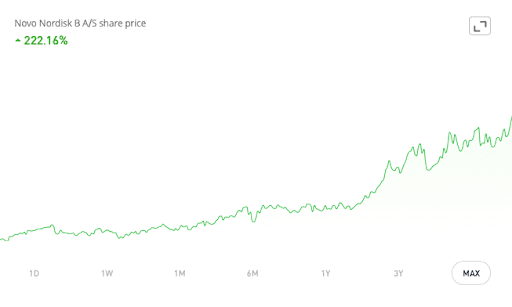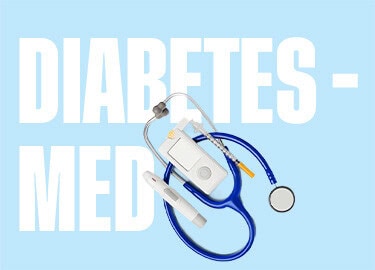Diabetes is one of the most significant health challenges facing society today. The seventh-highest cause of death worldwide, it currently affects around one in 10 people. Worryingly, its prevalence is expected to rise significantly in the years ahead. By 2030, 643 million people globally are predicted to have the disease, up from 537 million in 2021.
Of course, where there are challenges, there are also opportunities and we are seeing this here. Today, there are a handful of major healthcare companies, as well as hundreds of disruptive start-ups, that are developing innovative new solutions designed to enhance the diagnosis, treatment, and management of diabetes.
This new technology is changing the game for those with the condition. It is also creating lucrative opportunities for investors. Just look at the share price of Danish diabetes company Novo Nordisk, which generated revenue of more than $20 billion last year — it has skyrocketed in recent years.

Past performance is not an indication of future results.
Copy Trading does not amount to investment advice. The value of your investments may go up or down. Your capital is at risk.
How diabetes is treated and managed currently
While there is currently no cure for diabetes, it can be treated and managed effectively at present. Technological advancements — ranging from glucose monitors to insulin delivery devices — have made a huge difference in this regard.
There are two main types of diabetes and treatment depends on which type you have. Type 1 is where your body does not make any insulin because your immune system attacks and destroys the cells that produce it. With this type of diabetes — which is usually diagnosed in children and adolescents — you need to take insulin on a daily basis to maintain your blood glucose levels and stay alive. In contrast, Type 2 is where your body does not make good use of the insulin it produces. This variation of the condition — which tends to be associated with unhealthy lifestyles and poor nutrition — is more common than Type 1 and accounts for around 90% of all diabetes cases globally.
Glucose monitoring is an essential part of the treatment process for both Type 1 and Type 2 diabetes patients. This often involves finger-prick devices that pierce the skin with a needle so that a drop of blood can be taken for testing. Those with Type 1 diabetes typically need to check their glucose levels between four and 10 times per day. Meanwhile, those with Type 2 generally need to monitor their glucose levels around twice per day. Continuous glucose monitors (CGMs), which are made by the likes of DexCom and Roche’s Accu-Chek can be a huge help here. These medical devices, which have sensors beneath the skin, automatically track blood glucose levels, helping those with the disease to manage it more effectively.
Another major component of treatment is insulin therapy, particularly for those with Type 1 diabetes. This involves taking insulin via a pen, pump, or inhaler in order to control blood glucose levels. Danish healthcare company Novo Nordisk is one of the biggest players in this space, offering a range of different insulin therapy devices. Medtronic is another healthcare company that is active in this area.
Medication can also be part of the treatment process, especially for those with Type 2 diabetes. Medication typically aims to lower the amount of sugar in the blood or stimulate cells in the pancreas to make more insulin. Novo Nordisk, Eli Lilly, and Sanofi are some of the main players in this area.
Finally, education and lifestyle also play a key role in current treatment. Those with the condition are often encouraged to maintain a healthy lifestyle that includes plenty of physical activity and a nutritious diet. This can help them to keep their blood glucose levels within a normal range. It is worth noting that in some cases, Type 2 diabetes can be managed entirely through diet and exercise.
Copy Trading does not amount to investment advice. The value of your investments may go up or down. Your capital is at risk.
New technology is changing the game
While diabetes treatment has come a long way in recent decades, there is still plenty of room for improvement and right now there are many companies which are developing effective new solutions.
For example, in the glucose monitoring space, a number of companies are developing devices that are less invasive than traditional devices and eliminate the need for finger prick tests. DiaMonTech has developed technology that uses an invisible infrared light beam to look into your skin and count glucose molecules. Meanwhile, Medella Health is developing a smart contact lens that is able to test glucose levels in your tears. The device can provide real-time glucose readings, sending data to an app on your smartphone.
Similarly, a range of companies are developing solutions to improve the insulin delivery process. For instance, Companion Medical, which was acquired by Medtronic in 2020, has developed a reusable smart insulin pen that uses Bluetooth technology to provide dose calculations and tracking. Other companies such as DreaMed Diabetes and Capillary Biomedical have developed more comprehensive solutions that provide both continuous glucose monitoring as well as algorithm-based insulin delivery systems.
Disruptive companies are also working on novel ways to treat diabetes. In the CRISPR (gene editing) space, CRISPR Therapeutics and ViaCyte announced last year that Canada’s medical agency had approved their clinical trial application for VCTX210, a CRISPR-edited stem cell therapy designed to treat Type 1 diabetes by improving insulin production. Gene editing is considered to be one of the best chances of finding a cure for the disease.
MicroRNA gene expression technology is another form of technology that is being explored. RosVivo Therapeutics is developing a new treatment that uses microRNA technology to reverse the pathology of Type 2 diabetes. Its goal is to prevent those with diabetes from experiencing common long-term complications.
The areas of diagnostics, management, and virtual care are seeing plenty of innovation right now as well. In the diagnostics space, Glyconics is developing a range of handheld hardware devices that use infrared spectroscopy technology to diagnose the condition through changes in fingernail biomarkers. In terms of management, companies such as Fitterfly and Omada Health have developed digital therapies that support nutrition, fitness, and behavioural changes for improved diabetes management. And in the virtual care space, telehealth platforms such as Teladoc Health have established diabetes-specific care programs.
Putting this all together, technology looks set to be a game-changer for diabetes treatment.
Invest in diabetes stocks with eToro’s Diabetes-Med Smart Portfolio
Those interested in gaining portfolio exposure to diabetes care — an industry that is predicted to be worth more than $110 billion by 2027 — may want to check out eToro’s Diabetes-Med Smart Portfolio. Designed to help long-term investors capitalise on the investment opportunities created by the growing diabetes problem, this portfolio offers one-click access to insulin manufacturers, drug developers, medical device makers, research companies, and more.
Copy Trading does not amount to investment advice. The value of your investments may go up or down. Your capital is at risk.
This communication is for information and education purposes only and should not be taken as investment advice, a personal recommendation, or an offer of, or solicitation to buy or sell, any financial instruments. This material has been prepared without taking into account any particular recipient’s investment objectives or financial situation, and has not been prepared in accordance with the legal and regulatory requirements to promote independent research. Any references to past or future performance of a financial instrument, index or a packaged investment product are not, and should not be taken as, a reliable indicator of future results. eToro makes no representation and assumes no liability as to the accuracy or completeness of the content of this publication.



